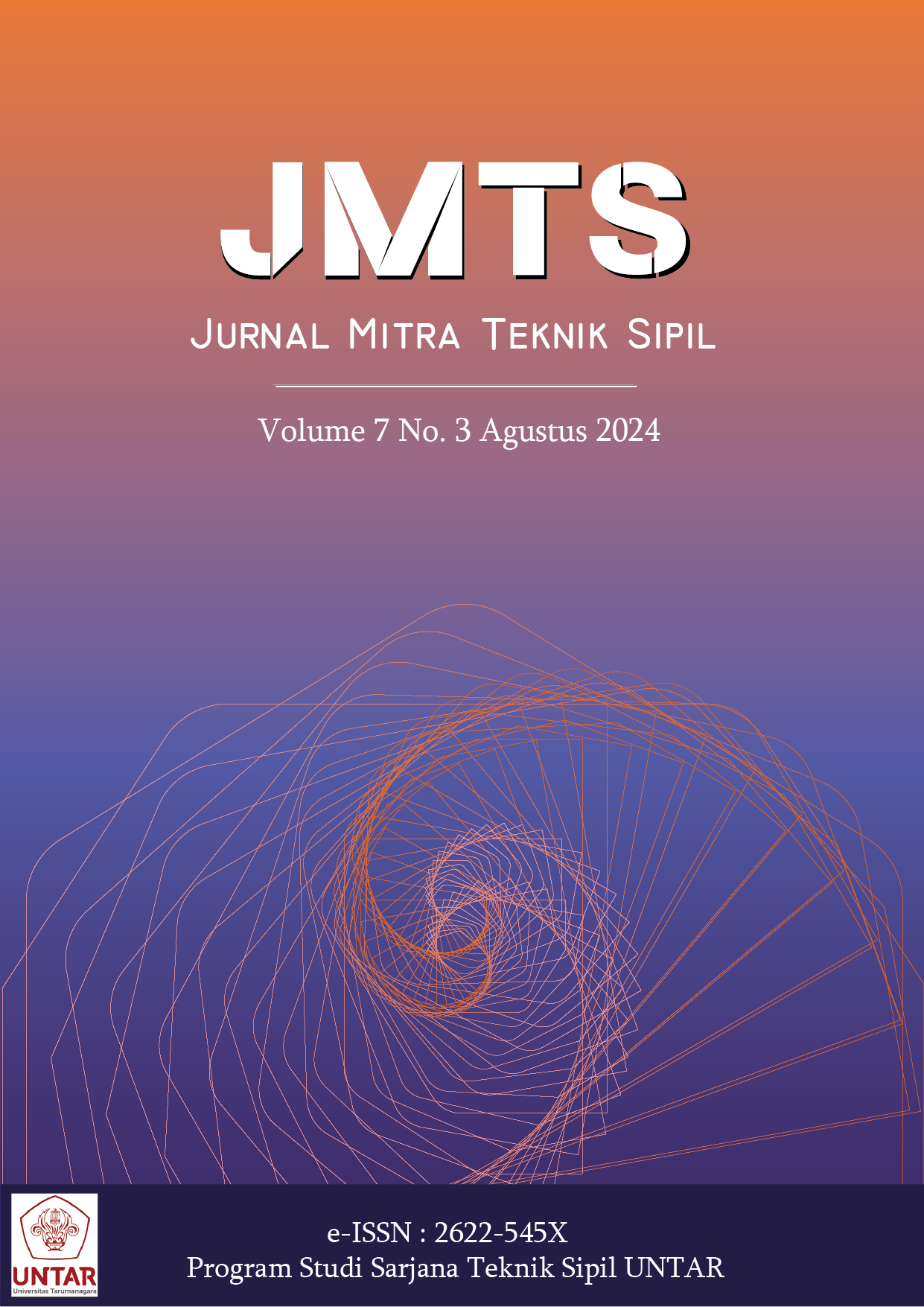PARTIAL STRESSING METHOD EFFECTIVENESS IN POST TENSION PRESTRESSED CONCRETE SYSTEM
Main Article Content
Abstract
Concrete material has moderately strong in compression but relatively weak in tension. To overcome this problem, we may apply three kinds of system, i.e., reinforced concrete (R/C) system, composite concrete (C/C) system, and prestressed concrete (P/C) system. In prestressed concrete system, a compressive force is applied to annihilate the tension region in the concrete section. Unfortunately, this compression force creates upward displacement, called camber, with such magnitude that may not be overcome by downward displacements due to the gravity loads. To reduce the magnitude of the troublesome camber, the camber can be decreased by reducing the magnitude of the prestressing force, by assigning some of the total moment to be resisted by additional mild steel. This kind of system, which is called the partial stressing system, is the main concern of this study. The objective of this study is to investigate the effectiveness of partial stressing method in reducing the camber due to the fully stressing method in post tension prestressed concrete system. The research deals with the partial stressing system applied to two cases i.e., rectangular and box girder types based on the real project of bridge girders. The maximum total moment is divided into two portions, one portion is carried out by prestressing tendon, and the other portion is carried out by mild steel. The results of this study indicated that the application of the partial system effectively reduces the magnitude of the cambers due to the fully stressing system. The linear reduction of prestressing force results in linear reduction of the camber for both cases of the rectangular and the box girder types. The box girder has better performance in reducing the stresses and the camber. Since the camber has been reduced significantly by the application of the partial stressing system, hence reduces the construction cost of bridge girders considered.
Abstrak
Material beton memiliki kuat tekan yang cukup kuat tetapi relatif lemah terhadap gaya tarik. Untuk mengatasi masalah ini, dapat diterapkan tiga macam sistem, yaitu sistem beton bertulang (R/C), sistem beton komposit (C/C), dan sistem beton prategang (P/C). Dalam sistem beton prategang, gaya tekan diterapkan untuk menghilangkan daerah tegangan di bagian beton. Sayangnya, gaya tekan ini menciptakan perpindahan ke atas, yang disebut camber atau kelengkungan, dengan besarnya sedemikian rupa sehingga tidak dapat diatasi oleh perpindahan ke bawah karena beban gravitasi. Untuk mengurangi besarnya camber yang bermasalah, kita dapat mengurangi camber dengan mengurangi besarnya gaya prategang, dengan menetapkan sebagian momen total yang harus ditahan oleh baja tulangan tambahan. Sistem semacam ini, yang disebut sistem tegangan parsial, menjadi perhatian utama dari studi ini. Tujuan dari penelitian ini adalah untuk mengetahui efektivitas metode tegangan parsial dalam mereduksi camber akibat metode tegangan penuh pada sistem beton prategang pasca tarik. Penelitian ini membahas tentang sistem tegangan parsial yang diterapkan pada dua kasus yaitu tipe gelagar persegi panjang dan gelagar kotak berdasarkan proyek nyata dari gelagar jembatan. Momen total maksimum dibagi menjadi dua bagian, satu bagian dilakukan oleh tendon prategang, dan bagian lainnya dilakukan oleh baja ringan. Hasil penelitian ini menunjukkan bahwa penerapan sistem parsial efektif mengurangi besarnya kelengkungan akibat sistem tegangan penuh. Pengurangan linier dari gaya prategang menghasilkan reduksi linier dari camber untuk kedua kasus tipe persegi panjang dan gelagar kotak. Gelagar kotak memiliki kinerja yang lebih baik dalam mengurangi tegangan dan camber. Karena camber telah berkurang secara signifikan dengan penerapan sistem tegangan parsial, konsekuensinya dapat mengurangi biaya konstruksi gelagar jembatan tersebut.
Article Details

This work is licensed under a Creative Commons Attribution-NonCommercial-ShareAlike 4.0 International License.
This work is licensed under Jurnal Mitra Teknik Sipil (JMTS) Creative Commons Attribution-ShareAlike 4.0 International License.References
Badan Standardisasi Nasional. (2004). Perencanaan struktur beton untuk jembatan (RSNI T-12).
Badan Standardisasi Nasional. (2005). Pembebanan untuk jembatan (RSNI T-02).
Bruggeling, A. (1985). Partially prestressed concrete structures - A design challenge. PCI Journal, 30(2), 140-171.
Choudary, K., & Akhtar, S. (2019). Application of partial prestressing for crack control in reinforced concrete structures. AIP Conference Proceedings 2158, 020027. https://doi.org/10.1063/1.5127151
Hariandja, B. (2013). Analisis dan perencanaan struktur beton bertulang, Universitas Pancasila.
Hariandja, B. (2015). Mekanika rekayasa III: Analisis struktur dengan metoda gaya dan metoda perpindahan, Institut Teknologi Bandung.
Hariandja, B. (2016). Analisis dan desain struktur beton prategang, Institut Teknologi Bandung.
Honarvar, E., Nervig, J., He, W., Sritharan, S., & Rouse, J. M. (2015). Improving the accuracy of camber predictions for precast pretensioned concrete beams, final report (IHRB Project TR-625). Bridge Engineering Center, Iowa State University.
Karschner, K. A., & Scanlon, A. (2012). Effects of creep and shrinkage on time-dependent strain and curvature of R/C members. [Master Thesis, The Pennsylvania State University].
Lin, T.-Y. (1963). Design of prestressed concrete structures, John Wiley & Sons, Inc.
Nainggolan, T. M. (2018). Investigasi kegagalan balok beton prategang tol Becakayu. Institut Teknologi Bandung.
Nawy, E. G. (2001). Beton Prategang (3rd ed.). Erlangga.
Precast/Prestressed Concrete Institute (2008). PCI Design Handbook, Precast and prestressed concrete (7th ed.). Precast/Prestressed Concrete Institute.
Tadros, M. K., Fawzy, F., and Hanna, K. E. (2011). Precast, prestressed girder camber variability. PCI Journal, 56(1), 135–154.
Wijiastuti, Y., & Fatniawati, N. (2003). Analisis lendutan beton prategang parsial pada gelagar jembatan dengan metode approximate time step [Thesis, Universitas Islam Indonesia].






